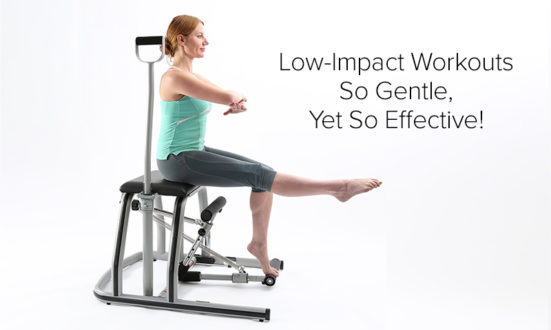We all know there’s more than one way to get a good workout. When it comes to cardio, you’ve got choices – high-intensity, low-intensity, high-impact, low-impact and even non-impact. It’s true that you can mix and match those options to meet your goals – for example, a high-intensity low-impact workout. But before we get into what all of those adjectives strung-together actually means, let’s define the one cardio option that often gets a bad rap as it’s the most misunderstood. The low-impact workout.
A common misconception is that low- and non-impact workouts like Pilates are easy or even wimpy. However, the actual definition of a low-impact workout actually implies a very specific characteristic…
Low-impact workouts include movement in which at least one foot (though sometimes both) is on the ground at all times. They increase your heart rate while minimizing the amount of stress or impact your joints are under. In other words, low- versus high-impact workouts are actually about how much force a movement puts on your body.
Consider walking (low-impact) versus running (high-impact). Running, in which both feet are off the ground for a period of time, puts high stress on your joints; while walking (even speed walking), in which one foot is on the ground at all times, creates much less force on your body, equaling less stress. Non-impact workouts are just what you would imagine—workouts that do not involve jarring impact on your joints. Swimming is one example.
Benefits of Exercises Without High Impact
Low- and non-impact workouts have myriad benefits. It’s obvious that you’ll lower your risk of injury because you put less stress on the body overall. In this way, low-impact is a great workout option for those who already deal with restrictions like arthritis, injury recovery or obesity. It’s also a great choice for those who are new to exercise because they can get into the routine of exercise without risking overuse injuries. Along those lines, low-impact is more sustainable over prolonged periods of time. In fact, you can work out more often and recover more quickly on a low-impact workout with less overall stress to the body. Sound good?
But what about calorie burn? Can you actually burn calories and build muscle as well as a high-impact workout?! The short and sweet answer is yes. Here’s the secret: You want to aim for high-intensity yet low-impact. Enter, strength training. You are stationary — typically both feet are on the ground – and yet exercises like squats or deadlifts are pretty darn heart-pumping and intense. Studies show significant weight loss and fat burn with a strength training program. If you’re not a dumbbell kind of person, consider resistance bands to take your body weight exercises to the next level. Bands can also improve mobility and range of motion – yet another boon to some low-impact workouts.
Low- and Non-Impact Workout Options
What are other ways to move your body while being gentle on your joints?
Walking: Notably one of the most effective and easiest of low-impact workout options, walking is a great way to build cardiovascular endurance. You could speed up your pace to take your intensity up a notch or even try walking with poles to facilitate upper-body activation.
Swimming: This one’s for you, in particular, if you have joint issues like osteoarthritis because you are close to zero gravity and that sacred “no-impact” zone.
Spinning®: Ah yes, a personal favorite for us here at Mad Dogg Athletics, Spinning® takes the weight off your joints and engages your muscles while strengthening your cardio system. You can ramp up intensity lickety-split on the bike and get that golden “high-intensity non-impact” workout you might seek.
And last, though certainly not least…
Pilates: Pilates is primarily a non-impact workout option because it is inherently stabilizing – workouts include sitting, lying or standing movements in all three planes that are guided by the powerhouse. Your body uses either gravity or a wide variety of other spring-based equipment to provide assistance and resistance. You can do Pilates on a mat or with a chair, reformer, Pilatesstick®, and/or pieces that convert from reformer to tower. All Pilates equipment has slightly different benefits and challenges, so try them all – especially since home workouts can be built around your own personal space and budget requirements.
Remember in Pilates, you are working with your own muscles and bodyweight (not momentum from pounding the earth) to gain strength. Pilates also helps build stability, flexibility and stamina, especially for postural muscles. And this…is why it’s a favorite non-impact workout for so many, including us!



